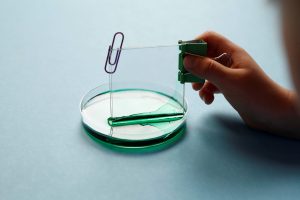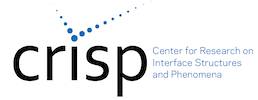Our kits are currently being reviewed and updated by a team of collaborative, innovative and interdisciplinary educators who wish to enhance the educational opportunities for students. These dedicated teachers are members of CRISP Collaborative Science for All (CCSA) as well as local educators.
Click to see the SCSU CRISP Module Template used by CCSA for improving and updating the CRISP demos and kits. Each kit page offers a CRISP developed teacher module and CRISP aligned standards (both NGSS and CCSS)
Kit Request form

The water level between the two acrylic pieces rose as a result of capillary action. Capillary action is the ability of a liquid to flow in narrow spaces—even against gravity. The water level was higher where the pieces were closer together and the space was narrower. As capillary spaces get smaller and smaller, liquids can move farther and faster.
Adapted from NanoDays Toolkits originally created for NISEnet via the NanoDays project
This material is based upon work supported by the National Science Foundation Award Numbers 0532536 and 0940143. Any opinions, findings, and conclusions expressed in this material are those of the authors and do not necessarily reflect the views of the National Science Foundation.
Subject(s):
Forces, Chromatography, Properties of materials
Objectives:
Students will observe how at the nanoscale things behave in surprising ways, and gain a better understanding of how technologies and society influence each other
Materials in this kit:
- Filters
- Water-soluble markers
- Squeeze bottle of water
- Lab-on-a-chip & paper diagnostics sheet
- Acrylic capillary action setup (two acrylic squares, binder clip, paper clip, petri dish, food coloring)
- Paper towels (optional for clean up)
Suggestions for the Teacher:
Timing: It may take a few moments for the liquid to rise up between the acrylic squares. Do the coffee filter activity first and come back to the demo afterwards to see how much the water moved.
Safety:
Students should not drink the dyed water
Additional Resources:
Capillary Action Teacher Module
Capillary Action Guide from NanoDays
Capillary Action CRISP aligned standards
NanoDays Capillary Action website (Great resources!)
STEM Careers:
Standards:
5-PS1-1
Develop a model to describe that matter is made of particles too small to be seen
MS-ETS1-1 Engineering Design
Define the criteria and constraints of a design problem with sufficient precision to ensure a successful solution, taking into account relevant scientific principles and potential impacts on people and the natural environment that may limit possible solutions.
HS-ETS1-1 Engineering Design
Analyze a major global challenge to specify qualitative and quantitative criteria and constraints for solutions that account for societal needs and wants.
MS - ETS1.A: Defining and Delimiting Engineering Problems
- The more precisely a design task’s criteria and constraints can be defined, the more likely it is that the designed solution will be successful. Specification of constraints includes consideration of scientific principles and other relevant knowledge that are likely to limit possible solutions.
HS - ETS1.A: Defining and Delimiting Engineering Problems
- Criteria and constraints also include satisfying any requirements set by society, such as taking issues of risk mitigation into account, and they should be quantified to the extent possible and stated in such a way that one can tell if a given design meets them.
- Humanity faces major global challenges today, such as the need for supplies of clean water and food or for energy sources that minimize pollution, which can be addressed through engineering. These global challenges also may have manifestations in local communities.
Interdependence of Science, Engineering, and Technology
- All human activity draws on natural resources and has both short and long-term consequences, positive as well as negative, for the health of people and the natural environment. (MS)
- The uses of technologies and limitations on their use are driven by individual or societal needs, desires, and values; by the findings of scientific research; and by differences in such factors as climate, natural resources, and economic conditions. (MS)
- New technologies can have deep impacts on society and the environment, including some that were not anticipated. Analysis of costs and benefits is a critical aspect of decisions about technology. (HS)
SEP 1 - Asking Questions and Defining Problems
- Define a design problem that can be solved through the development of an object, tool, process or system and includes multiple criteria and constraints, including scientific knowledge that may limit possible solutions.(MS)
- Analyze complex real-world problems by specifying criteria and constraints for successful solutions.(HS)
SEP 2 – Developing and Using Models
- Use models to describe phenomena.
